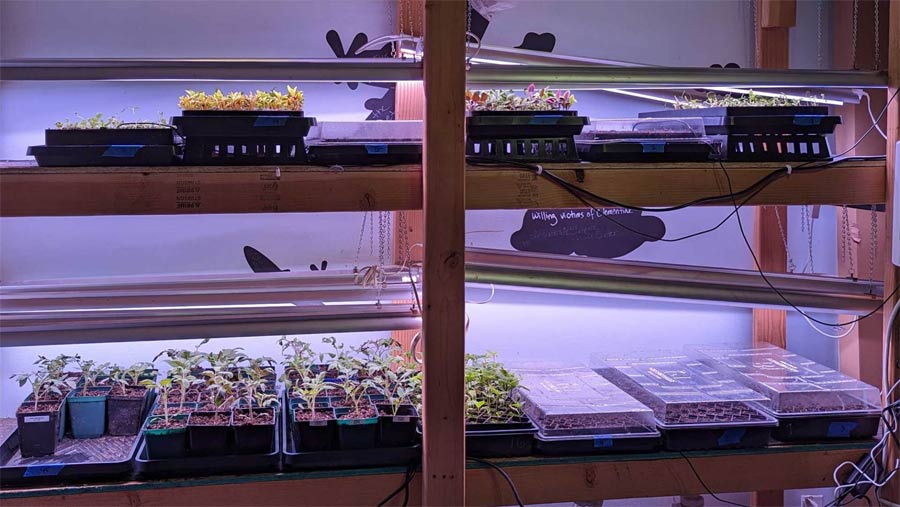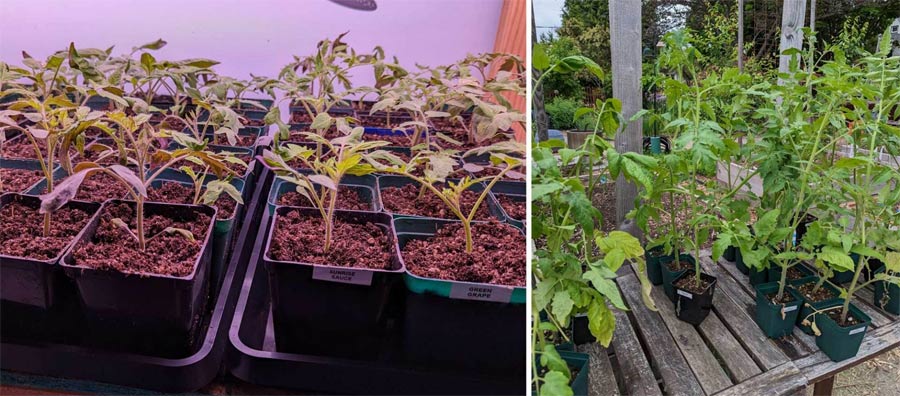Common mistakes when sowing seeds
Planting seeds is a relatively simple process: Bury the seed in soil, add water, heat and sunlight, and in most cases the seed will germinate. The problem is, most of us do this process indoors due to space constraints in the city, where there isn't as much soil as in the countryside.

The environment for growing plants in the city is sometimes lacking in sunlight, the temperature is difficult to control, and the roots are also limited by the pot. Therefore, when sowing seeds indoors in the city, you need to pay more attention to taking care of them. Below are common mistakes when sowing seeds that should be avoided to ensure good plant growth.
Lack of light
This is one of the easiest problems to diagnose, because it is also one of the most likely to occur. Remember, when growing seeds indoors, you are trying to simulate sunlight. When estimating light needs, this factor is always underestimated. The signs are easy to spot: Your seedlings will be 'lanky' with long stems that are not strong enough to support their leaves. The stems will often be crooked, almost like the plant has scoliosis. The seedlings may also bend toward the light.
The solution, of course, is more light. First-time seed growers often buy a grow light to illuminate their entire seedling rack, while each tray needs 2,000-5,000 lumens. It's not just the intensity of the light, but also the duration: Seedlings need 14-16 hours of sunlight per day. The lights also need to be close to the seedlings. A good distance is 6-8 inches from your seedlings.
If your seedlings are already too tall, there are a few things you can try. First, if it's a tomato or a bell pepper, you can bury the stem deep into the soil when you plant the seedlings in pots or outdoors, and this will solve many of the problems. If it's another type of seedling, like a cucumber, they don't usually need such a strong stem and will likely adjust over time. Running a fan in the room and running your hand over the seedlings a few times a day will both help strengthen the stems.
Too much light
It's actually pretty easy to tell if your plants are getting too much or too little light. Just like us, plants can get sunburned. They develop scorch marks where the top leaves have almost white or yellow spots. These spots also have no pattern.
Now, seedlings are susceptible to a variety of diseases, fungi, and viruses, so you may be wondering if this is sunburn or something else. The good news is that it doesn't matter because the solution is the same: Cut it off. Sunburned leaves can't absorb light or nutrients and won't recover, so cut them off completely and let the rest of the plant recover. Obviously, move the lights further away, just enough distance away.

No germination
Of all the seeds you plant, some won't germinate. There are a lot of reasons for that, but let's look at the most likely ones. First, you may have buried your seeds too deep or not deep enough. On the back of every seed packet there are instructions on how deep to bury them—and they're not blanket recommendations. While the difference between planting seeds 1 inch or 1.5 inches deep may not seem significant, there's a big difference between seeds that need to be lightly covered—like carrots and most flowers—and those that need to be buried, like tomatoes, peppers, cucumbers, and sunflowers. Another telltale sign: The larger the seed, the deeper you need to bury it.
If the seeds sit in wet soil for too long and do not germinate, then it is likely that the seeds have rotted. You just need to replant the seeds.
Another reason could be that the seeds have expired. Every seed has an expiration date. It can be very short, like onions, which are good for only one year. Experienced gardeners will know that this is just a guideline; you can always test your seeds by trying to plant them in soil to see if they germinate.
Too much water
Too much water, even if the plant survives, will prevent your seedlings from developing a healthy root system. Watering just enough is best, and a little bit is fine, as long as the plant has enough water to survive, as it causes the roots to stretch out in search of more resources, forming a healthier root system. Watering methods for seedlings that allow them to absorb only the amount of water they need are ideal, such as watering from the bottom up, leaving a little water in the tray for the soil to soak up. But even when watering from the top down, you want the soil to be slightly moist, but never soggy.
Yellowing leaves or a limp plant are usually signs of overwatering. If the plant starts to smell bad, it is likely that mold is growing in the water, which is also a sign of too much water. In these cases, the solution is to do the opposite and use less water. Your plant may or may not recover. If you trim away any rotten roots or limp leaves and stems, the plant may recover.
However, most seedlings will develop some green or white fungus on the soil surface, and this is not always a bad sign. If the plant is still growing well, you do not need to do anything.

Lack of water
Drooping seedlings often need water. Tomato plants in particular will start to lean over and look quite sad. This can happen towards the end of a watering cycle, and is a sign that you should give them a watering. The plants should perk up immediately, within an hour or two of watering.
If the soil is really dry, that is never a good sign. It is best to keep the bed slightly moist. If you are having trouble keeping the soil moist, consider watering from the bottom up, as this is a consistent method. The soil absorbs what it needs.
Above are common mistakes of people who plant seeds for the first time. Hope the article is useful to you.
You should read it
- Discovered the 2800-year-old ancient seed found in Turkey
- Eating watermelons do not like to eat nuts, this article will help you change your mind
- Benefits of Chia Seeds for Hair
- What is bo bo seed?
- How to add seeds to seedless watermelon?
- How to grow mango and longan from seeds super quickly to have a super beautiful bonsai pot
 Tips for effective 10-finger typing
Tips for effective 10-finger typing 13+ fastest ways to download Youtube videos to your computer
13+ fastest ways to download Youtube videos to your computer How to determine someone's location from IP address?
How to determine someone's location from IP address? 5 Simplest Ways to Reduce Zip File Size
5 Simplest Ways to Reduce Zip File Size Simple tips to help clothes last longer
Simple tips to help clothes last longer How to grow mango and longan from seeds super quickly to have a super beautiful bonsai pot
How to grow mango and longan from seeds super quickly to have a super beautiful bonsai pot